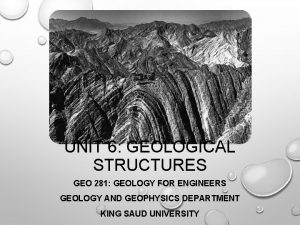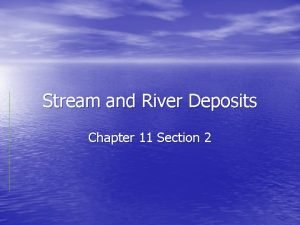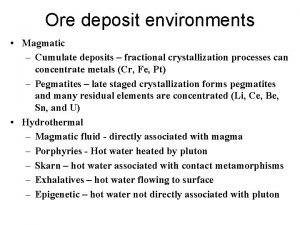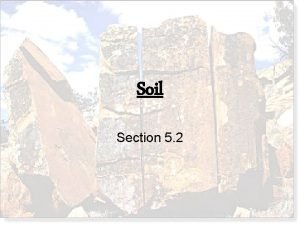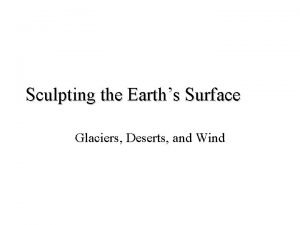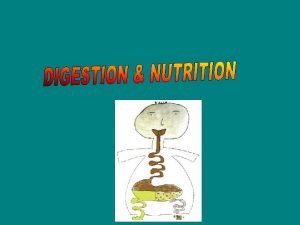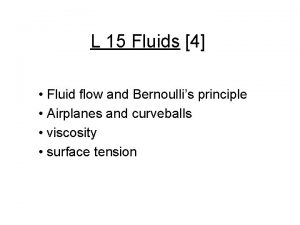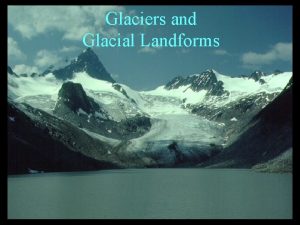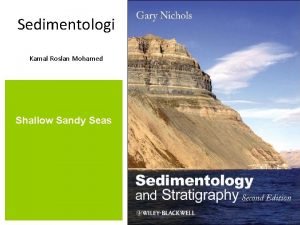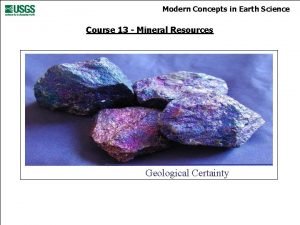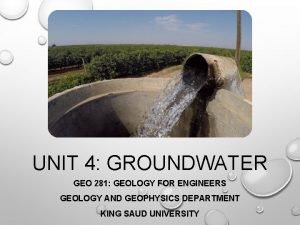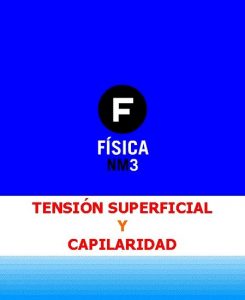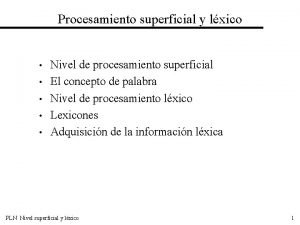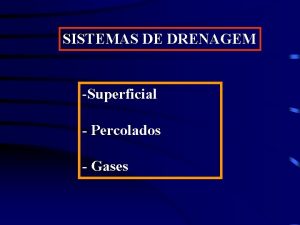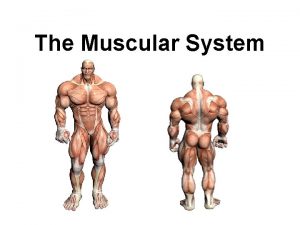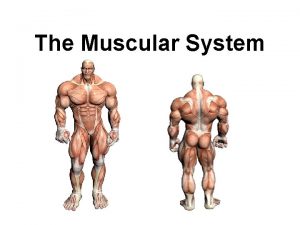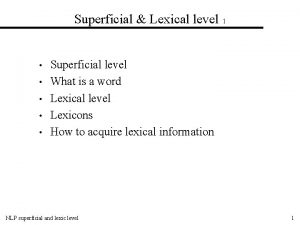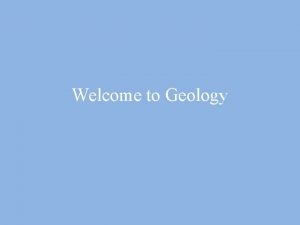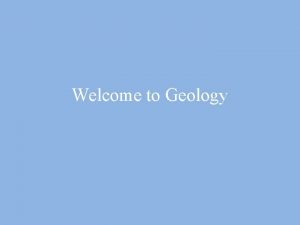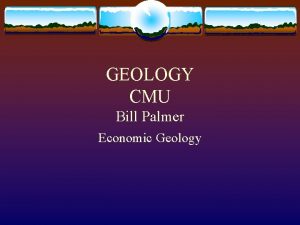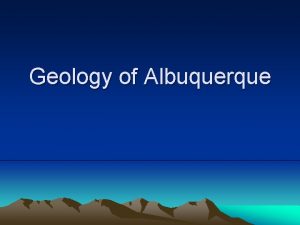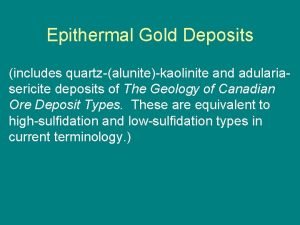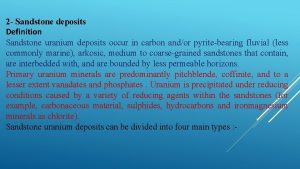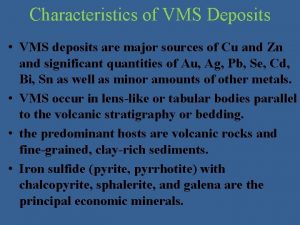UNIT 3 SUPERFICIAL DEPOSITS GEO 281 GEOLOGY FOR




































- Slides: 36

UNIT 3: SUPERFICIAL DEPOSITS GEO 281: GEOLOGY FOR ENGINEERS GEOLOGY AND GEOPHYSICS DEPARTMENT KING SAUD UNIVERSITY

WEATHERING AND SOIL • Weathering, mass wasting, and erosion are called external processes because they occur at or near Earth’s surface and are powered by energy from the Sun. • External processes are a basic part of the rock cycle because they are responsible for transforming solid rock into sediment. • Earth is a dynamic body. Some parts of Earth’s surface are gradually elevated by mountain building and volcanic activity. These internal processes derive their energy from Earth’s interior.

EXTERNAL PROCESSES • Weathering—the physical breakdown (disintegration) and chemical alteration (decomposition) of rocks at or near Earth’s surface. • Mass wasting—the transfer of rock and soil downslope under the influence of gravity. • Erosion—the physical removal of material by mobile agents such as water, wind, or ice. • However, weathering cannot be easily separated from mass wasting and erosion, because as weathering breaks rocks apart, mass wasting and erosion remove the rock debris. • This transport of material by mass wasting and erosion further

WEATHERING • Weathering goes on all around us, but it seems like such a slow and subtle process that it is easy to underestimate its importance. • Many of the life-sustaining minerals and elements found in soil, and ultimately in the food we eat, were freed from solid rock by weathering processes. • Weathering occurs when rock is mechanically fragmented (disintegrated) and/or chemically altered

TYPES OF WEATHERING • Mechanical weathering is accomplished by physical forces that break rock into smaller and smaller pieces without changing the rock’s mineral composition. • Chemical weathering involves a chemical transformation of rock into one or more new compounds. • Weathering is the response of Earth materials to a changing environment. • Although these two categories separately, keep in mind that mechanical and chemical weathering processes usually work simultaneously in nature and reinforce each other.

MECHANICAL WEATHERING • When a rock undergoes mechanical weathering, it is broken into smaller and smaller pieces, each retaining the characteristics of the original material. The end result is many small pieces from a single large one. • In nature, four physical processes are especially important in breaking rocks into smaller fragments: • Frost wedging, • Salt crystal growth, • Expansion resulting from unloading, and • Biological activity.

MECHANICAL WEATHERING (FROST WEDGING) • If you leave a glass bottle of water in the freezer a bit too long, you will find the bottle fractured. • The bottle breaks because water has the unique property of expanding about 9 percent upon freezing. • This is also the reason that poorly insulated or exposed water pipes rupture during frigid weather. • You might expect this same process to fracture rocks in nature. • This is, in fact, the basis for the traditional explanation of frost wedging. • After water works its way into the cracks in rock, the freezing water enlarges the cracks and angular fragments are eventually produced.

MECHANICAL WEATHERING (SALT CRYSTAL GROWTH) • Another expansive force that can split rocks is created by the growth of salt crystals. • Rocky shorelines and arid regions are common settings for this process. • It begins when sea spray from breaking waves or salty groundwater penetrates crevices and pore spaces in rock. • As this water evaporates, salt crystals form. • As these crystals gradually grow larger, they weaken the rock by pushing apart the surrounding grains or enlarging tiny cracks.

MECHANICAL WEATHERING (SHEETING) • When large masses of igneous rock, particularly granite, are exposed by erosion, concentric slabs begin to break loose. The process generating these onion like layers is called sheeting. • It is thought that this occurs, at least in part, because of the great reduction in pressure when the overlying rock is eroded away, a process called unloading. • Accompanying this unloading, the outer layers expand more than the rock below and thus separate from the rock body. • Continued weathering eventually causes the slabs to separate and spall off, creating exfoliation domes.

MECHANICAL WEATHERING (BIOLOGICAL ACTIVITY) • Both mechanical and chemical weathering are accomplished by the activities of organisms. • Plant roots in search of minerals and water grow into fractures, and as the roots grow, they wedge the rock apart. • Burrowing animals further break down the rock by moving fresh material to the surface, where physical and chemical processes can more effectively attack it. • Of course, where rock has been blasted in search of minerals or for construction, the impact of humans is

CHEMICAL WEATHERING • Chemical weathering involves the complex processes that break down rock components and internal structures of minerals. • Such processes convert the constituents to new minerals or release them to the surrounding environment. • During this transformation, the original rock decomposes into substances that are stable in the surface environment. • Consequently, the products of chemical weathering will remain essentially unchanged as long as they remain in an environment similar to the one in which they formed.

CHEMICAL WEATHERING (WATER AND CARBONIC ACID) • Water is by far the most important agent of chemical weathering. • Although pure water is nonreactive, a small amount of dissolved material is generally all that is needed to activate it. • Oxygen dissolved in water will oxidize some materials. • For example, when an iron nail is found in moist soil, it will have a coating of rust (iron oxide), and if the time of exposure has been long, the nail will be so weak that it can be broken as easily as a toothpick. • When rocks containing iron-rich minerals oxidize, a yellow to reddish-brown rust will appear on the surface.

CHEMICAL WEATHERING (WATER AND CARBONIC ACID) • Carbon dioxide (CO 2) dissolved in water (H 2 O) forms carbonic acid (H 2 CO 3), the same weak acid produced when soft drinks are carbonated. • Rain dissolves some carbon dioxide as it falls through the atmosphere, and additional amounts released by decaying organic matter are acquired as the water percolates through the soil. • Carbonic acid ionizes to form the very reactive hydrogen ion (H) and the bicarbonate ion (HCO 3). • For example, the mineral calcite (Ca. CO 3), which composes the common building stones marble and limestone, is easily attacked by even a weakly acidic solution. • The overall reaction by which calcite dissolves in water containing carbon dioxide is:

CALCITE WEATHERING • During this process, the insoluble calcium carbonate is transformed into soluble products. • In nature, over periods of thousands of years, large quantities of limestone are dissolved and carried away by underground

WEATHERING OF SILICATE MINERALS • Silicate minerals make up most of Earth’s crust and that these minerals are composed essentially of only eight elements. • When chemically weathered, silicate minerals yield sodium, calcium, potassium, and magnesium ions that form soluble products, which may be removed by groundwater. • The element iron combines with oxygen, producing relatively insoluble iron oxides, which give soil a reddish-brown or yellowish color. • Under most conditions the three remaining elements: aluminum, silicon, and oxygen: join with water to produce residual clay minerals.

WEATHERING OF SILICATE MINERALS

RATE OF WEATHERING • Several factors influence the type and rate of rock weathering. • We have already seen how mechanical weathering affects the rate of weathering. • By breaking rock into smaller pieces, the amount of surface area exposed to chemical weathering is

FACTORS AFFECTING WEATHERING (ROCK CHARACTERISTICS) • Rock characteristics encompass all of the chemical traits of rocks, including mineral composition and solubility. • In addition, any physical features such as joints (cracks) can be important because they allow water to penetrate rock and start the process of weathering long before the rock is exposed. • Granite, which are composed of silicate minerals, are relatively resistant to chemical weathering. • Marble is composed of calcite (calcium carbonate), which readily dissolves even in a weakly acidic solution. • The silicates, the most abundant mineral group, weather in essentially the same order as their order of crystallization.

FACTORS AFFECTING WEATHERING (CLIMATE) • Climatic factors, particularly temperature and moisture, are crucial to the rate of rock weathering. • One important example from mechanical weathering is that the frequency of freeze–thaw cycles greatly affects the amount of frost wedging. • Temperature and moisture also exert a strong influence on rates of chemical weathering. • The optimal environment for chemical weathering is a combination of warm temperatures and abundant moisture. • In polar regions chemical weathering is ineffective because frigid temperatures keep the available moisture locked up as ice, whereas in arid regions there is insufficient moisture to foster rapid chemical weathering. • Human activities can influence the composition of the atmosphere, which in turn can impact the rate of chemical weathering. One well-known example is acid rain

DIFFERENTIAL WEATHERING • Masses of rock do not weather uniformly. • Many factors influence the rate of rock weathering. • Among the most important are variations in the composition of the rock. • More resistant rock protrudes as ridges or pinnacles, or as steeper cliffs on an irregular Hillside. • Differential weathering and subsequent erosion are responsible for creating many unusual and

SOIL • Soil covers most land surfaces. • Along with air and water, it is one of our most indispensable resources. • All life: the entire biosphere - owes its existence to a dozen or so elements that must ultimately come from Earth’s crust. • Once weathering and other processes create soil, plants carry out the intermediary role of assimilating the necessary elements and making them available to animals, including humans.

WHAT IS SOIL • With few exceptions, Earth’s land surface is covered by regolith: the layer of rock and mineral fragments produced by weathering. • Some would call this material soil, but soil is more than an accumulation of weathered debris. • Soil is a combination of mineral and organic matter, water, and air and is that portion of the regolith that supports the growth of plants. • Although the proportions of the major components in soil vary, the same four

WHAT IS SOIL • About one-half of the total volume of a good quality surface soil is a mixture of disintegrated and decomposed rock (mineral matter) and humus, the decayed remains of animal and plant life (organic matter). • The remaining half consists of pore spaces among the solid particles where air and water circulate. • Although the mineral portion of the soil is usually much greater than the organic portion, humus is an essential component. • In addition to being an important source of plant nutrients, humus enhances the soil’s ability to retain water. • Because plants require air and water to live and grow, the portion of the soil consisting of pore spaces that allow for the circulation of these fluids is as vital as the solid soil constituents.

FACTORS AFFECTING SOIL FORMATION (PARENT MATERIAL) • The source of the weathered mineral matter from which soils develop is called the parent material and is a major factor influencing a newly forming soil. • Parent material might be the underlying bedrock, or it can be a layer of unconsolidated deposits, as in a stream valley. • When the parent material is bedrock, the soils are termed residual soils. • By contrast, those developed on unconsolidated sediment are called transported soils. • The nature of the parent material influences soils in two ways. First, the type of parent material affects the rate of weathering and thus the rate of soil formation. • Second, the chemical make-up of the parent material affects the soil’s fertility. This influences the character of the natural vegetation the soil can support.

FACTORS AFFECTING SOIL FORMATION (PARENT MATERIAL)

FACTORS AFFECTING SOIL FORMATION (CLIMATE) • Climate is the most influential control of soil formation. • Temperature and Precipitation are the climatic elements that have the strongest impact on soil formation. • Variations in temperature and precipitation determine whether chemical or mechanical weathering predominates. • They also greatly influence the rate and depth of weathering. • For instance, a hot, wet climate may produce a thick layer of chemically weathered soil in the same amount of time that a cold, dry climate produces a thin mantle of mechanically weathered debris. • Also, the amount of precipitation influences the degree to which various materials are removed (leached) from the soil, thereby affecting soil fertility.

FACTORS AFFECTING SOIL FORMATION (PLANTS AND ANIMALS) • The biosphere plays a vital role in soil formation. • The types and abundance of organisms present have a strong influence on the physical and chemical properties of a soil. • Plants and animals furnish organic matter to the soil. • Soil fertility depends in part on the amount of organic matter present. • The decay of plant and animal remains causes the formation of various organic acids. These complex acids hasten the weathering process. • Organic matter also has a high water-holding ability and thus aids water retention in a soil.

FACTORS AFFECTING SOIL FORMATION (TOPOGRAPHY) • Variations in topography can lead to the development of a variety of localized soil types. • Many of the differences exist because the length and steepness of slopes have a significant impact on the amount of erosion and the water content of soil. • On steep slopes, soils are often poorly developed. In such situations little water can soak in; as a result, soil moisture may be insufficient for vigorous plant growth. • In contrast, waterlogged soils in poorly drained bottomlands have a much different character. Such soils are usually thick and dark. The dark color results from the large quantity of organic matter that accumulates because saturated conditions retard the decay of vegetation. • The optimum terrain for soil development is a flat-to-undulating upland surface. Here we find good drainage, minimum erosion, and sufficient infiltration of water into the soil.

FACTORS AFFECTING SOIL FORMATION (TOPOGRAPHY)

THE SOIL PROFILE • Because soil-forming processes operate from the surface downward, variations in composition, texture, structure, and color gradually evolve at varying depths. • These vertical differences, which usually become more pronounced as time passes, divide the soil into zones or layers known as horizons. • If you were to dig a trench in soil, you would see that its walls are layered. Such a vertical section through all of the soil horizons

THE SOIL PROFILE • An idealized view of a well-developed soil profile has five horizons. • From the surface downward, they are designated as O, A, E, B, and C, respectively. • These five horizons are common to soils in temperate regions. • The characteristics and extent of development of horizons vary in different environments. • Thus, different localities exhibit soil profiles that can contrast greatly with one another.

THE SOIL PROFILE • The O horizon consists largely of organic material. This is in contrast to the layers beneath it that consist mainly of mineral matter. • Underlying the organic-rich O horizon is the A horizon. This zone is largely mineral matter, yet biological activity is high and humus is generally present at up to 30 percent in some instances. • Together the O and A horizons make up what is commonly called topsoil. • Below the A horizon, the E horizon is a light-colored layer that contains little organic material. • As water percolates downward through this zone, finer particles are carried away. • Water percolating downward also dissolves soluble inorganic soil components and carries them to deeper zones. This depletion of soluble materials from the upper soil is termed leaching.

THE SOIL PROFILE • Immediately below the E horizon is the B horizon, or subsoil. • Much of the material removed from the E horizon is deposited in the B horizon, which is often referred to as the zone of accumulation. • The accumulation of the fine clay particles enhances water retention in the subsoil. • The O, A, E, and B horizons together constitute the solum, or true soil. It is in the solum that the soil-forming processes are active and that living roots and other plant and animal life are largely confined.

THE SOIL PROFILE • Below the solum and above the unaltered parent material is the C horizon, a layer characterized by partially altered parent material. • Whereas the O, A, E, and B horizons bear little resemblance to the parent material, it is easily identifiable in the C horizon. • The characteristics and extent of development can vary greatly among soils in different environments. • A well-developed soil profile indicates that environmental conditions have been relatively stable over an extended time span and that the soil is mature. • By contrast, some soils lack horizons altogether. Such soils are called immature, because soil building has been going on for only a short time. • Immature soils are also characteristic of steep slopes where erosion continually strips away the soil, preventing full development.

THE SOIL PROFILE

SOIL AS AN ENGINEERING MATERIAL • The term "soil" means different things to different people: To a geologist it represents the products of past surface processes. To a pedologist it represents currently occurring physical and chemical processes. To an engineer it is a material that can be: • • built on: foundations to buildings, bridges. built in: tunnels, culverts, basements. built with: roads, runways, embankments, dams. supported: retaining walls, quays. • Engineers' descriptions give engineering terms that will convey some sense of a soil's current state and probable susceptibility to future changes (e. g. in loading, drainage, structure, surface level). • Engineers are primarily interested in a soil's mechanical properties: strength, stiffness, permeability. These depend primarily on the nature of the soil grains, the current stress, the water content and unit weight.
 Geo 281
Geo 281 Formation of soil
Formation of soil Coral phone system
Coral phone system Cs281 wordpress
Cs281 wordpress Cpr e 281
Cpr e 281 281-284-0027
281-284-0027 Cs 281
Cs 281 Numeros romanos del 1 al 100
Numeros romanos del 1 al 100 Stoytchev 281
Stoytchev 281 Stoytchev 281
Stoytchev 281 Dönem ayirici hesaplar 180 181 280 281 380 381
Dönem ayirici hesaplar 180 181 280 281 380 381 Dönem ayirici hesaplar 180 181 280 281 380 381
Dönem ayirici hesaplar 180 181 280 281 380 381 Chapter 11 section 2 stream and river deposits answer key
Chapter 11 section 2 stream and river deposits answer key Fossil fuel deposits
Fossil fuel deposits Ore deposits
Ore deposits What is the function of a commercial bank
What is the function of a commercial bank Personal bank account 7 habits examples
Personal bank account 7 habits examples Pedalfer soils would most likely be found
Pedalfer soils would most likely be found Sedex ore deposits
Sedex ore deposits A petty cash fund is always replenished ____.
A petty cash fund is always replenished ____. Chapter 4 checking accounts answer key
Chapter 4 checking accounts answer key The multiple expansion of checkable deposits
The multiple expansion of checkable deposits Emotional bank account examples
Emotional bank account examples Metamorphic rocks in michigan
Metamorphic rocks in michigan Calcium deposits
Calcium deposits Glacial deposits
Glacial deposits Calcium deposits
Calcium deposits Calcium deposits
Calcium deposits Piedmont
Piedmont Ritika deposits 200 every month
Ritika deposits 200 every month Sarita deposits $1000 in an account
Sarita deposits $1000 in an account Tidal deposits
Tidal deposits Mvt deposits
Mvt deposits Falatiron
Falatiron Fractional reserve banking
Fractional reserve banking As coal deposits were used up, britain turned to
As coal deposits were used up, britain turned to Unit 6 review questions
Unit 6 review questions
